While the world is enthralled by Kashmir Pashmina, we today start from the very beginning. How does a simple wool variety transform into such luxury apparel and wraps?
Pashm - The Raw Material for Pashmina
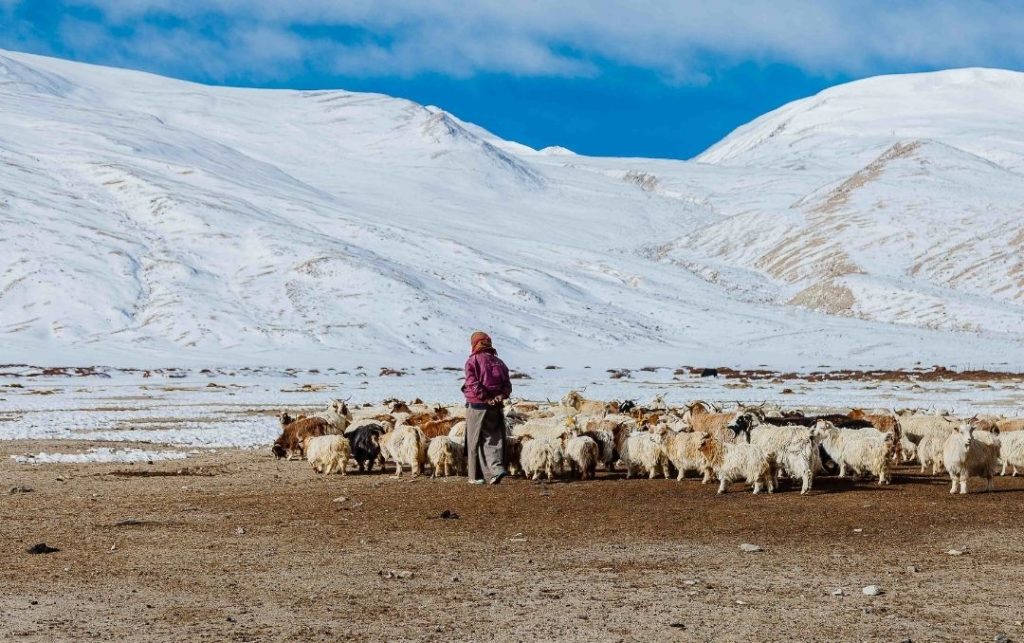
As soon as the biting winds of winter howl around the high plateaus of the Himalayas, it is the local animals that remain unaffected. Be it goats, antelope, camels, oxen, or yaks, each animal residing in the local environment grows fine fibres beneath their outer coat, which helps them fight the bone-chilling cold of the mountains. It is noteworthy that this part of the Himalayan range plummets to -40 degree Celsius in winter, and nature has gifted the animals an inner fleece that keeps their bodies unaware of the outer weather's ferocity.
Winter leaves and brings the pleasant spring in. The comparatively longer and brighter spring days trigger hormonal changes in the body of the animals, especially the goats. These discarded inner coats of these exotic animals have been long used by humans for their own use. Camels, yaks, and goats are domestic animals, and their coats are easier to acquire, whereas Tibetan antelopes have not been domesticated, and hence have to be slaughtered for the procurement of their fibre.
The most famous of these inner fleece varieties is Cashmere - a superfine wool - that grows on the body of Changthangi goats. This goat is found in the Changthang area of Ladakh, which is situated over 14000 feet above sea level. The goat grows heavenly soft and fine fleece on its body, which keeps it warm and comfortable in winter. This wool is Cashmere. It is Cashmere that is later processed to make Pashmina shawls of Kashmir or Kashmiri Pashmina shawls. For this reason, the goat is often called the Pashmina goat.
Herders of the Pashmina goat
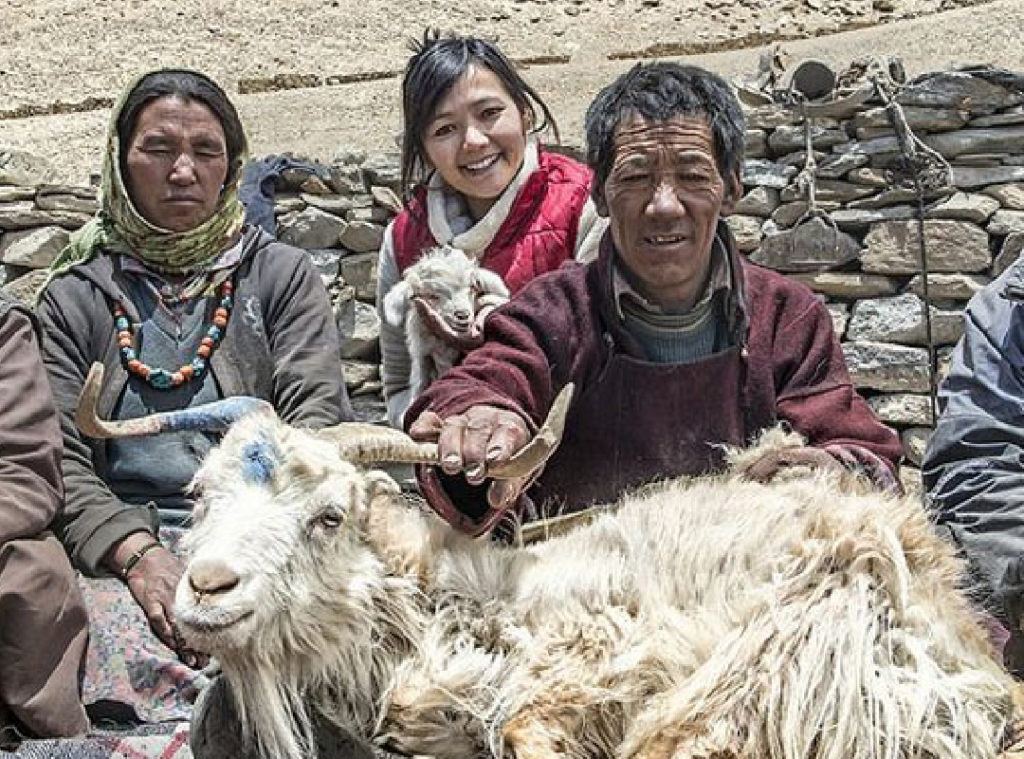
Herders of these exotic Ladakhi goats are from a Buddhist tribe and are called The Changpa. These nomadic pastoralists erect yak hair tents at several places around this habitat and this has been so for centuries now. The primary job of these tribes is rearing their animals, and hence investing in them as far as their milk, wool, meat, or hair is concerned. For this reason, when winters approach, and temperatures are known to plummet to -50 degrees C even, the tribes remain safe from the cold, as garments made from goat and yak hair save them.
The Changpa tribe of Ladakh is around 7000 to 8000 people. They are divided into different tribes, and each tribe has a leader. The tribes are around 15-18 and have 150 members on average. Each group shares the same beliefs and lifestyle.
Pastoralism is the basic activity of the Changpa tribe. But some also grow barley and potatoes and engage in agricultural activities. Sheep, Pashmina goats, and yak are the primary livestock that the tribe rears. These animals are found in thousands around the area.
The export of Ladakhi goat wool from Kashmir remains a contact activity. This activity has improved the relations between these two places immensely. Ladakhi Cashmere is the main Cashmere found in Kashmir, even though western Tibet, too, exports Cashmere around the world.
Making Kashmir Pashmina shawls from Cashmere
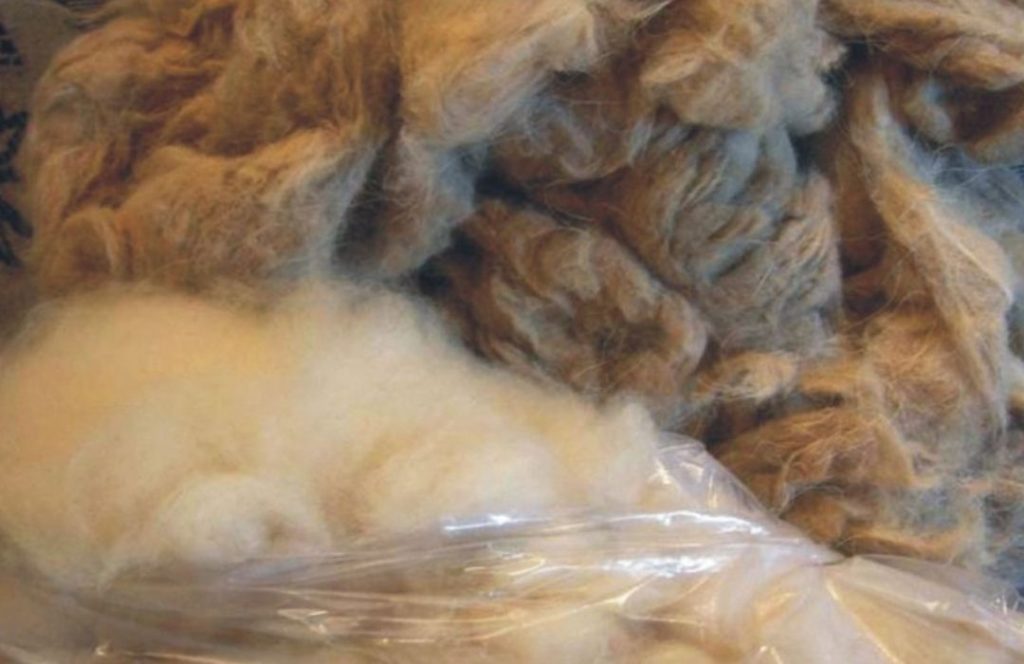
Even though Cashmere is the softest and most luxurious fibre in the world, as soon as it reaches Kashmir, it is a greasy and muddy lump. The wool is full of vegetable waste, foreign fibre, guard hair of the goat, and dirt attached to the goat's body. Hence it needs thorough cleaning and sorting. To transform this filthy lump into heavenly soft shawls takes the patience and centuries-old practice of artisans, craftsmen and labourers. Spinners, dyers, weavers, embroidery artisans, and around a hundred hands take turns to transform the raw wool into gossamer fine Pashmina shawls of Kashmir.
This wonderful art of Pashmina has been existing since the 16th century. It has been hundreds of years since the advent of Pashmina took place in Kashmir itself. Kashmir was the only region where raw Cashmere was processed as skillful artisans were native to it. The qualities of Cashmere - the heavenly soft wool - were truly recognized by the locals, who made it a point for the fibres to achieve their most favourable position. Hence Pashmina shawls of Kashmir were chosen by the elite, the affluent, and most by the royal court members.
Processing Cashmere for Kashmir Pashmina shawl
Processing the wool takes place in a number of steps. To start with, raw wool is washed off of all impurities that are attached to it. Post this, it is placed in pounded/powdered rice, where it gains luster and strength, essential for the upcoming processes. This mixture is combed again, resulting in a clean, stronger, and fine wool lump.
Spinning
This lump is mounted onto a spinning wheel, called Yinder locally. Yinder is worked upon by womenfolk of Kashmir, and with the perfect rhythm of hands, the lump is transformed to fine threads, long, smooth and gossamer thin. These are all processed and collected to be handed over for weaving
Weaving
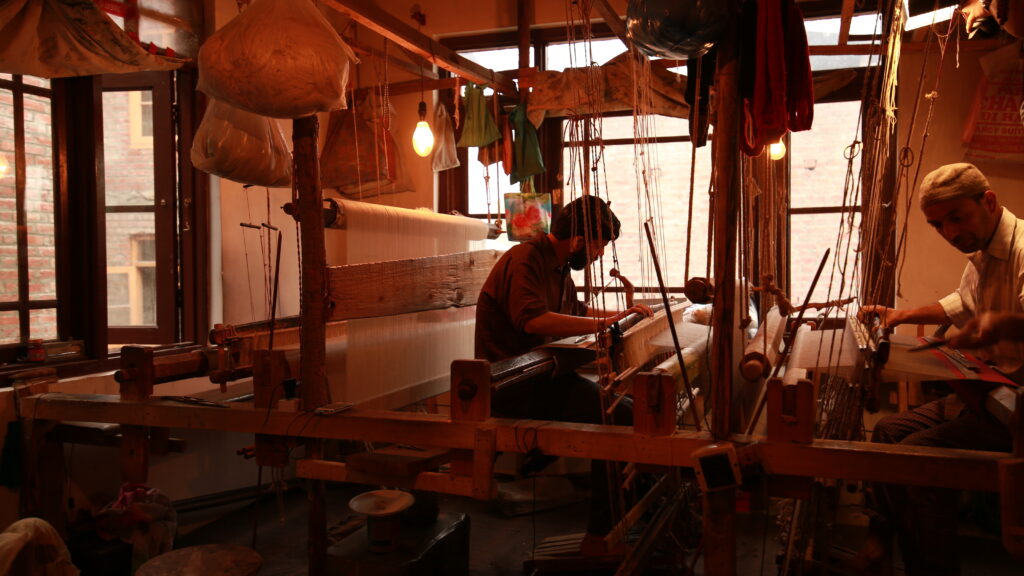
Weaving is the process of converting fine threads of Cashmere to the fabric. For this purpose, a traditional wooden handloom is chosen which treats the fine threads gently. Two or three men sit across this handloom and attach the threads to its heddles. This takes around 3 to 4 days. Then it is handwoven for another 3 to 4 days, till fibre turns to the fabric. In this way, a Kashmiri Pashmina shawl or stole, or any size wrap is prepared. The shawl is still in a solid form and needs embellishment if required.
Even though solid Pashmina shawls have a grace of their own, some like their shawls printed, patterned, embroidered, or laced. It usually depends on the age of the person and the occasion when it is to be worn.
Types of Kashmir Pashmina shawls
Pashmina shawls have a number of types, based on the embellishments done on them. Solid shawls are preferred by a few ladies, but most like their shawls embellished. Here is a classification of the Pashmina shawls of Kashmir.
Solid shawls
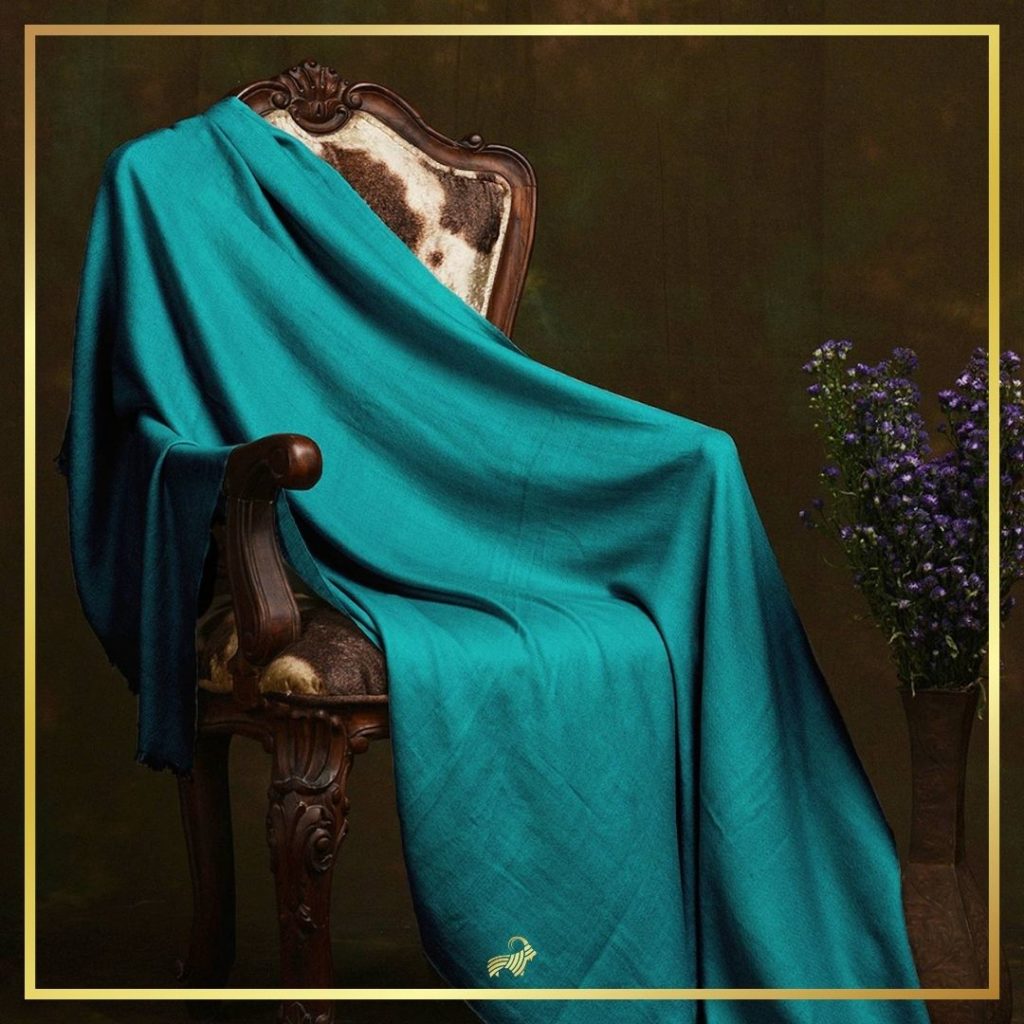
Solid shawls are those which are free from any adornment. These are straight out of the loom, yet some finishing is needed for these too. Solid shawls are mostly worn by younger women, or by those who work, in their offices. Casual occasions too demand minimalism, hence solid shawls can be chosen for such occasions.
Ombre Dyed shawls
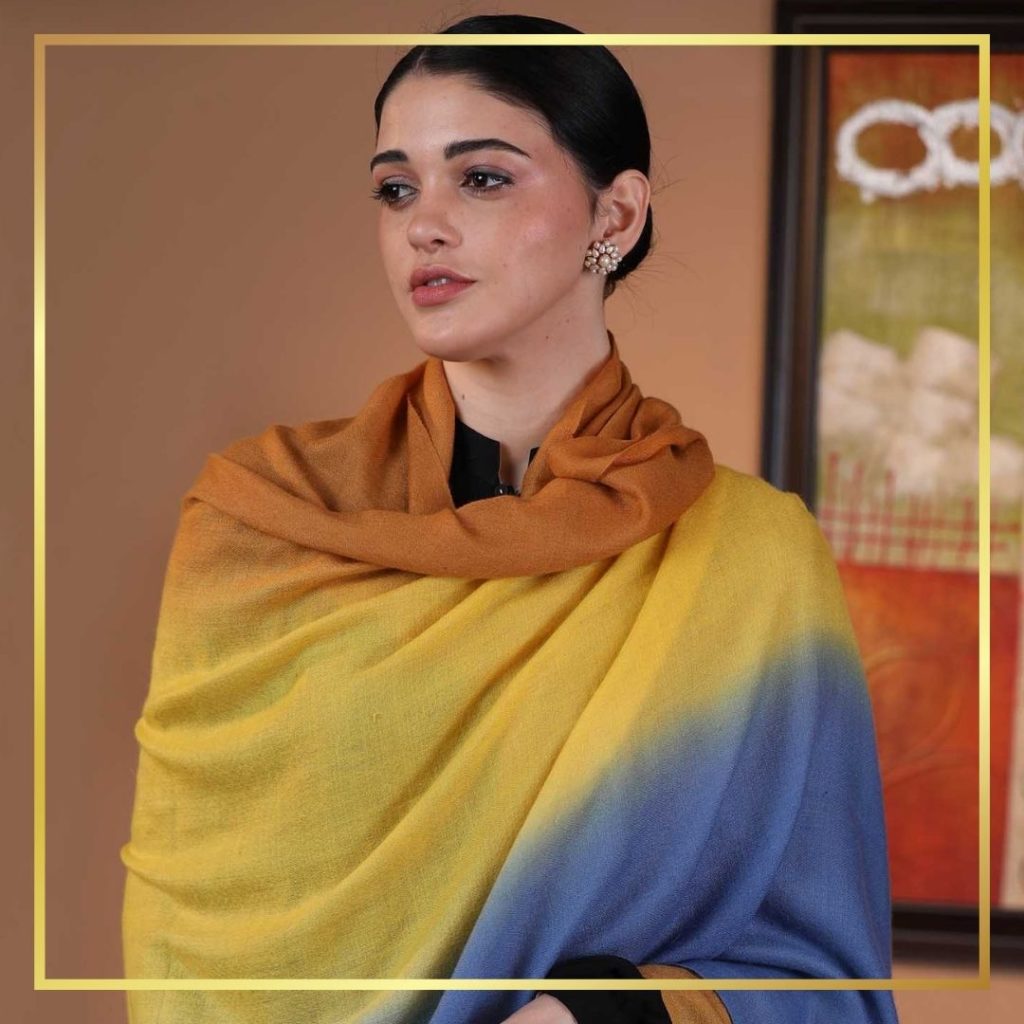
Ombre Dyed shawls are dyed in vegetable dues, as harsh chemical dyes can ruin Pashmina shawls. These beautiful wraps take two or more colours, and finally become the utmost elegant. Ombre shawls too are ideal for a casual meetup.
Reversible Pashmina shawls
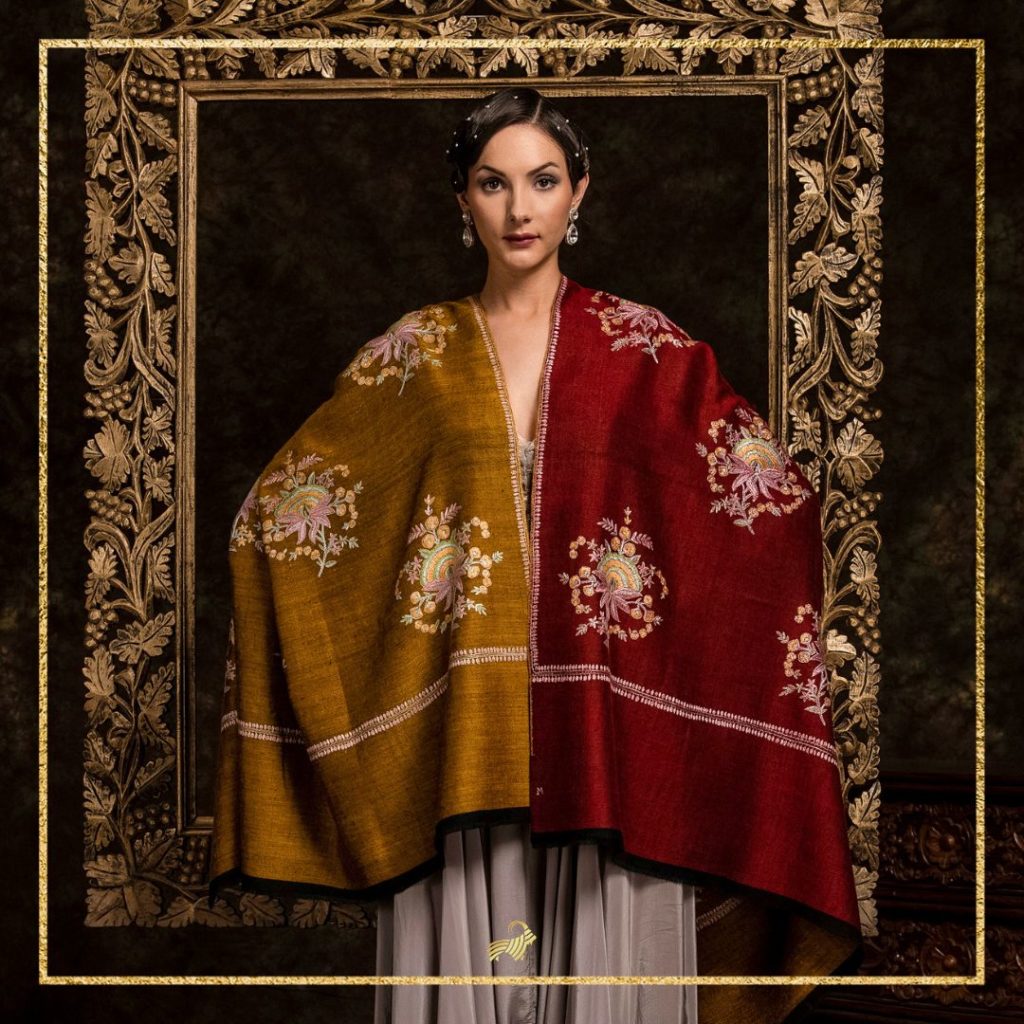
Reversible shawls can be worn from both sides, and do not have a front and back portion. This is the genius and skill of Kashmiri artisans who can weave a shawl with no back, and both sides look equally elegant. Reversible shawls were one of those shawls which existed during the Mughal period, besides solids and embroidered ones.
Patterned Pashmina Shawls
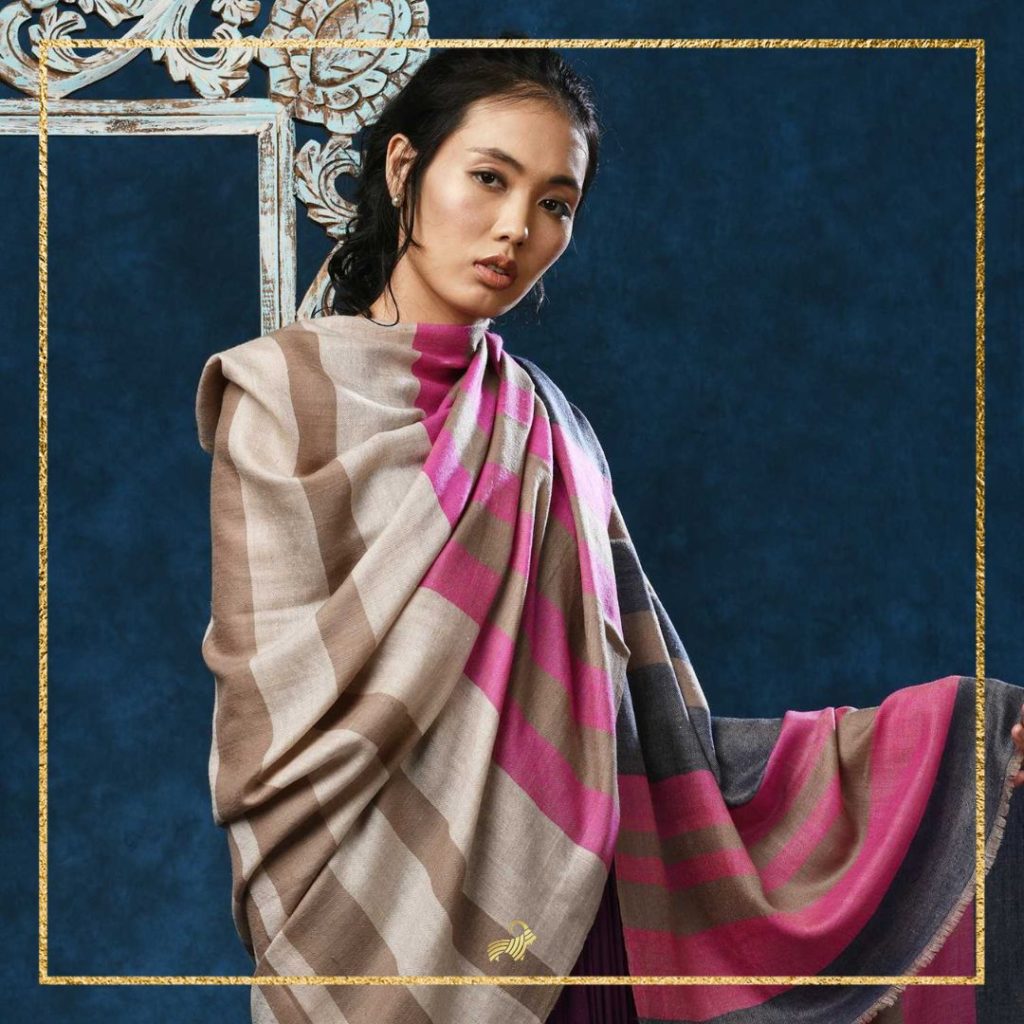
Patterned shawls consist of patterns, which are in trend at a current time. These shawls were crafted keeping in mind the contemporary needs of women. Hence patterns like stripes, checks, herringbone weaves, abstract patterns, geometric patterns, and more, were chosen to aggrandize solid shawls. These are worn on semi-formal, formal, and even casual occasions.
Lace Pashmina shawls
Laced shawls, too, like patterned shawls were invented later to quench modern needs. These shaws can host any type of laces, but the French Chantilly laces are the most preferred ones, as these are regal and lightweight. Lace shawls look beautiful for weddings or semi-formal events.
Printed Pashmina Shawls
Printed Pashminas go with everything. These are preferred by younger women who love to carry the in-vogue trends. As such, artisans adapt and print the shawls with current trends. Animal prints, floral prints, abstract prints, or paisley prints are chosen to adorn these shawls with hundreds of colors and shades.
Swarovski Crystal Shawls
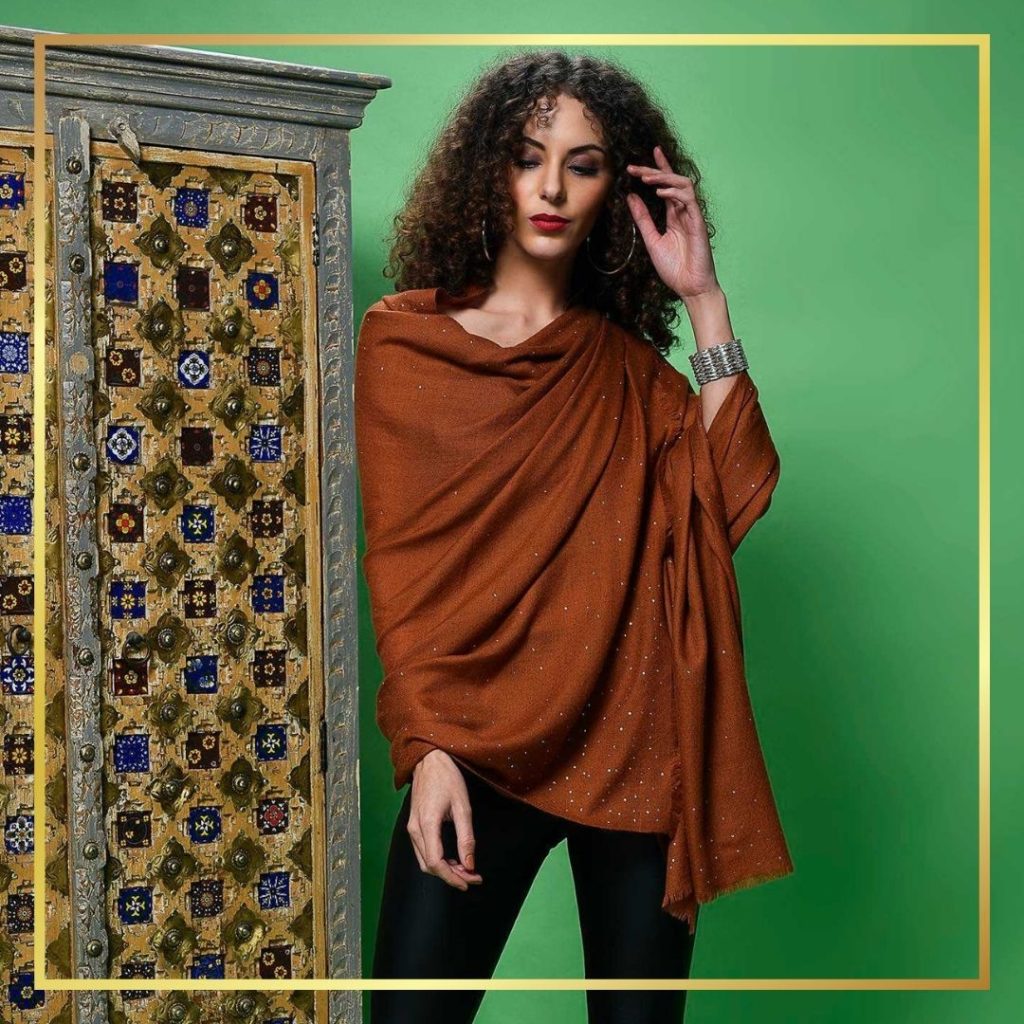
The freshest addition to Pashmina, Swarovski crystals adds the bit of shimmer that lacks in Pashmina shawls. Cashmere is a natural fibre, and is hence matte. So the glitz is provided by these studs which make their wearers look more blingy and stylish.
Embroidered Pashmina Shawls
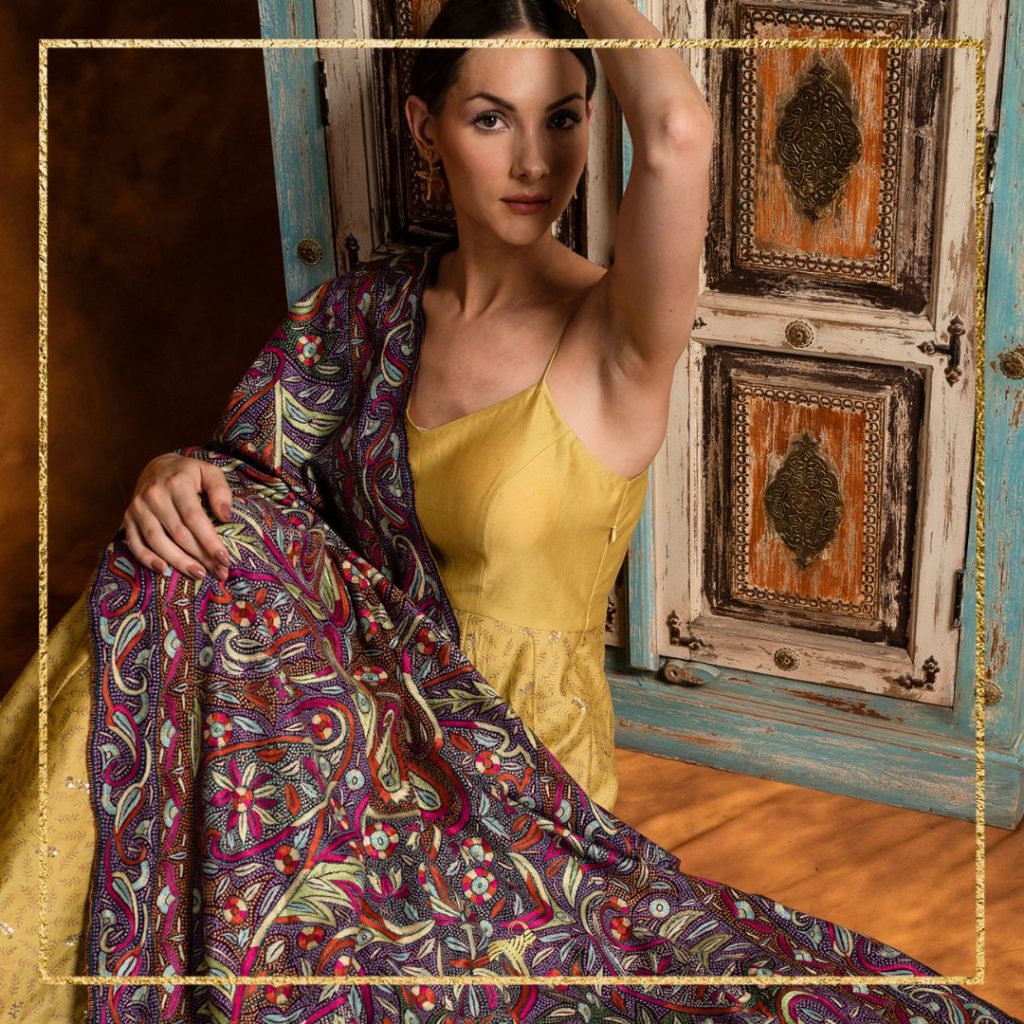
The first embellishment that Pashmina shawls ever got was hand embroidery. Persian craftsmen trained the locals in a number of hand embroidery styles, and that is what we witness till now, and not a bit has changed as far as the elegance of these styles is concerned. There are mainly three embroidery staples done over Pashmina shawls. These are:
- Sozni Kari: fine thread and needle embroidery.
- Tilla Dozi: an embroidery pattern in which the thread is metallic, dipped in gold or silver.
- Papier Mache: an embroidery style where thicker threads and needles are used to craft thicker motifs, full of rainbow colours.
Based on the embroidery style, Kashmiri shawls are again classified as follows:
- Jamawar: a shawl consisting of full embroidery, where the underlying base is barely visible.
- Jaalidaar: A shawl with embroidery all over the base, but keeping the base visible with motifs spread like a net.
- Dordaar: A shawl where an embroidery vine runs along the four borders. The embroidery vine can, however, be thick or thin, on the basis of customer choice.
- Bootidaar: a shawl where large motifs are spread at equal distances from each other, all over the shawl.
Kani Pashmina shawls of Kashmir
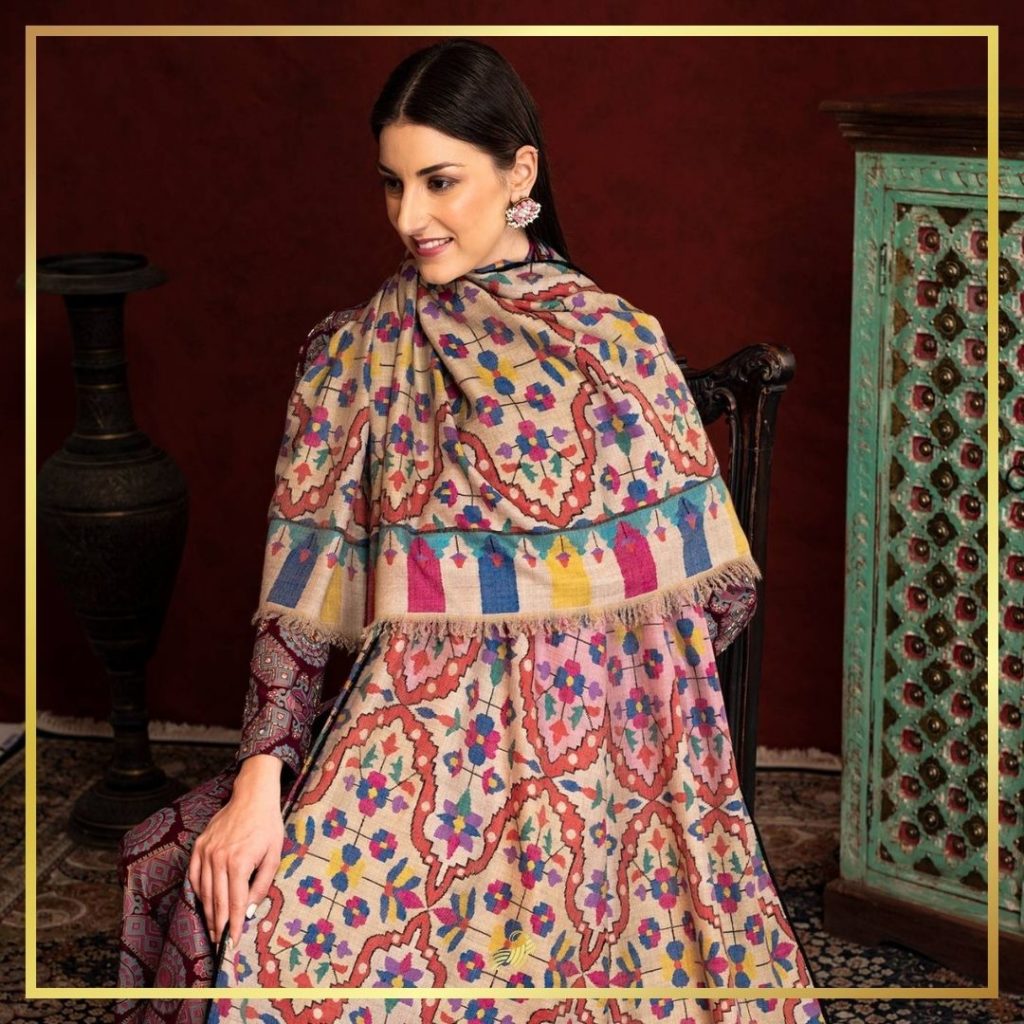
Last, but definitely, not less than any other of the above, is the Kani shawl of Kashmir. This shawl looks embroidered, but the plethora of colours over it are actually woven into the base. Kani shawl weaving is a unique art, and its artists are distinct. Kani shawls represent the utmost skill and patience of Kashmiri artisans and have fascinated the world. From Mughal rulers to those ruling European countries, it was the Kani shawl of Kashmir which brought it immense glory and fame.
To prepare a Kani shawl, the artisan needs small wooden sticks called Kanis. Threads of brilliant colours are wound around these sticks. During the weaving process, the warp of the shawl is Cashmere threads, whereas, in the weft section, these Kanis are introduced. Like the lyrics of a song, there is a code written by a writer, and according to this code, the shawl is to be handwoven. The shawl is nothing less than living art.
Also read: KASHMIRI SHAWL FOR WEDDINGS
Love for Kashmiri Pashmina
Emperor Akbar had such great fondness for Kashmiri Pashmina that he owned a large number of these. It is, in fact, believed that he gave it the name “parn narm”, which translates to “supersoft”. Not just Mughal Kings and queens, but Indian nobles, Iranian royalty, French empresses, and British court members desired just one piece of this luxurious art form.
Pashmina art inspired many around the world to imitate the same. But no one could even approach the fascinating art of Pashmina making. The distinctive charm, the unique processing, and the regal grace that a Kashmiri Pashmina had were simply unparalleled. Its imitations were nowhere close to the actual art. No Cashmere in the world was as supremely soft as Ladakhi Cashmere, and hence the Pashmina shawls made from Ladakhi Cashmere remained unmatched, till now. Ancient art like this one lasted long in the minds of art patrons, who even recognized Pashmina shawls with one touch. It is, in fact, believed that a few Pashmina makers could recognize Pashmina shawls from others by tasting a thread of the same.
Generations passed and modern times needed shawls to be made instantly. Hence, a fully embroidered shawl, which would be available in 3 to 4 years, would be possible in one year, if a machine would weave and embroider it. Hence the original Kashmiri Pashmina lost its glory in the fast fashion world. Slow and sustainable, Pashmina shawls would only be chosen by patrons of regal art.
Come what may, the term “Kashmiri Pashmina” still brings an expression of awe to the faces of women all over the world.